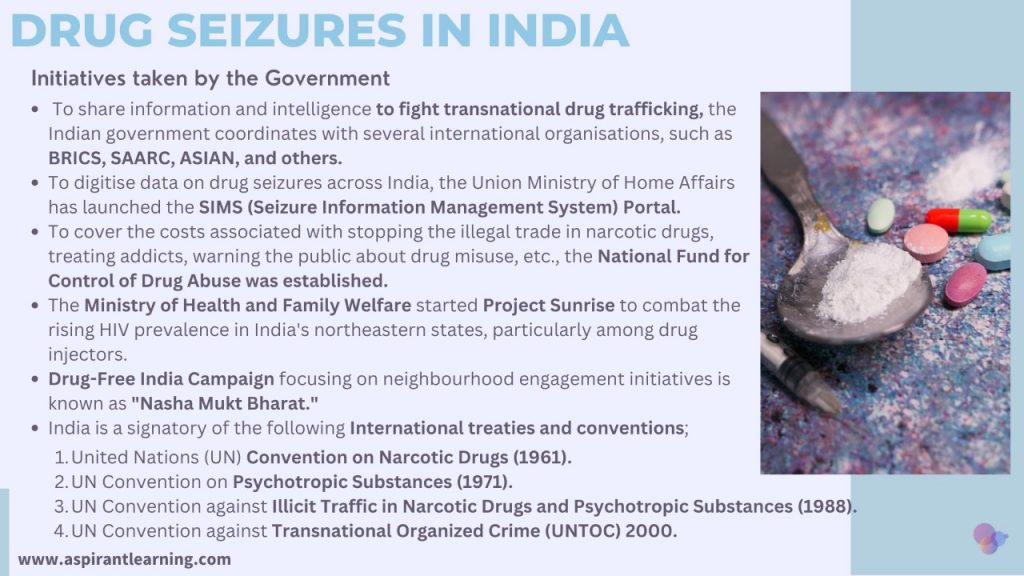News Highlight
Smuggling seizures in India: the recently released government report throws light on the innovative ways a range of items was smuggled in and out of India.
Key Takeaway
- Gold, dried seahorses, heroin and red sander logs are some examples of items seized by Indian Customs and the Directorate of Revenue Intelligence (DRI) in airports, along sea routes, and in border areas nearly every day.
Smuggling in India Report 2021-22
- The key highlights of the report
- Gold, heroin, and cocaine were found in record-breaking quantities near Mundra port.
- Myanmar took over from the Middle East as the main transit route for the smuggling of gold after the epidemic disrupted international aviation traffic.
- Drug trafficking also changed from a passenger-only activity to a cargo-only operation due to Afghanistan’s pandemic and political changes.
- Seizures of fake Indian currency notes (FICN) have increased in Bangladesh and Myanmar, which were used as staging grounds for smuggling FICN into India.
- The sophisticated extraction and concealment techniques smuggling organisations use to provide an increasing concern.
- As a result, of the disturbances in traditional hawala settlements, further challenges include the usage of cryptocurrencies, the dark web, and actual currency smuggling.
Drug seizures in India
- About
- Firstly, there has been a rise in drug seizures in the nation during the last five years.
- The Narcotics Control Bureau (NCB), Directorate of Revenue Intelligence (DRI), Indian Coast Guard, anti-terrorist squads (ATS), and Police are among the law enforcement organisations seizing significant amounts.
- According to a recent DRI report, the organisation’s latest fiscal year saw record-breaking seizures of high-value substances like cocaine, methamphetamine, and heroin.
- In addition, the data showed that the seizure of cocaine, a highly addictive party drug, increased 36-fold to 310 kg in 2021–22 from 8.7 kg in 2020–21 and just 1.1 kg in 2019–20, indicating a troubling trend.
- Methamphetamine seizures by the DRI have increased 14-fold, making it another high-value party drug.
- Compared to the 64.39 kgs in 2020–21, an estimated 884.69 kgs was confiscated in 2021–22.
- In addition, 3,410.71 kgs of heroin were found in 2021–2022—a 17-fold increase from the prior fiscal year.
- The DRI nationwide seized 143 kg of heroin in 2019–20 and 202 kg of heroin in 2020–21.
- India has become one of the single largest opiate markets in the world in the number of consumers.
- According to the World Drug Report 2022 from the UN Office on Drugs and Crime, published in June.
- According to the paper, there are already indications that opiate trafficking from Afghanistan may be intensifying as it moves eastward.
- Moreover, it makes the Indian market vulnerable to an increase in supply.
- Furthermore, Gujarat is currently the third-worst state for drug overdose mortality, trailing only Punjab and Himachal Pradesh in terms of opioid addiction in India.
Drug Menace in India
- Firstly, teenagers in India are becoming more and more addicted to drugs.
- India has almost 70 million drug users, according to a poll by the Ministry of Social Justice and Empowerment.
- In addition, it is a significant health issue that decimates the person affected and his whole family, the community, and the country.
- It encourages antisocial conduct, including theft, criminal activity, and violence.
- Generating unaccounted funds that are also utilised for financing terrorism and anti-national actions hinders the economic development of a nation.
- As a result, it poses a grave risk to national security.
- Furthermore, India is situated between the two countries that produce the most opium in the world:
- Thailand, Myanmar, Vietnam, and Laos make up the Golden Triangle on its eastern border.
- Pakistan, Afghanistan, and Iran can be seen as a golden crescent on the northwestern side.
What is the law that allows the destruction of seized drugs?
- Section 52-A of the Narcotics Drugs and Psychotropic Substances (NDPS) Act, 1985, allows probe agencies to destroy seized substances after collecting required samples.
- Officials concerned must make a detailed inventory of the substance to be destroyed.
- The area SSP, the director/superintendent or the area NCB representative, a local magistrate, and two other members with ties to the legal and law enforcement communities comprise the five-person group.
- The chemical is burned completely or incinerated in an incinerator, leaving no trace.
Which agency is authorised to carry out such an exercise?
- Any law enforcement agency with authority to confiscate drugs may also destroy them with the local magistrate’s prior approval.
- State police departments, the CBI, and the NCB are a few examples.
What is the need to destroy seized drugs?
- The harmful nature of narcotic medicines or psychotropic substances and their vulnerability to theft, substitution, and storage space limits are why authorities destroy them.
- There have been cases where seized drugs were stolen from the warehouse.
- To avoid such incidents, officials aim to destroy seized drugs as soon as they obtain the needed samples from the seized substances.

Way Forward
- Firstly, the state is required by Article 47 of the Directive Principles of State Policy of the Indian Constitution to promote public health and work toward outlawing the use of medicines and alcoholic beverages that are harmful to one’s health.
- Cross-border trafficking must be stopped, and India’s law enforcement must be strengthened.
- It’s essential to lessen the stigma attached to drug use.
- The general public must comprehend that drug addicts are victims, not criminals.
- Another option is appropriate counselling.
- Drug addiction, its effects, and de-addiction should all be covered in the education curriculum.
- In addition, improving the abilities of caretakers.
- Funding for programmes that are backed by evidence.
- Furthermore, creating programmes for vulnerable populations such as young people, street children, mothers, and inmates.
Pic Courtesy: Deccan Herald
Content Source: Tax concept



